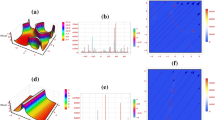Abstract
Waves with a large incidence angle in deep water can drive a morphodynamic instability on a sandy coast whereby shoreline sand waves, cuspate forelands, and spits can emerge. This instability is related to bathymetric perturbations extending offshore in the shoaling zone. Here, we explore a different mechanism where the large incidence angle is supposed to occur at breaking and the bathymetric perturbations occur only in the surf zone. For wave incidence angles at breaking above ≈ 45∘, the one-line approximation of coastal dynamics predicts an unstable shoreline. This instability (EHAWI) is scale-free and the growth rate increases without bound for decreasing wavelength. Here we use a 2DH morphodynamic model resolving surf zone instabilities to investigate whether EHAWI could approximate a real instability in nature with a characteristic length scale. Assuming very idealized conditions on the bathymetric profile and sediment transport, we find a 2DH instability mode consisting of shore-oblique up-current bars coupled to a meandering of the longshore current. This mode grows for high-angle waves, above about 30∘ (offshore) and the maximum growth rate occurs for the angle maximizing the angle at breaking, about 70∘ (offshore). The dominant wavelength is of the order of the surf zone width. Interestingly, for long sand waves, the growth rate never becomes negative and it matches very well the anti-diffusive behavior of EHAWI. This distinguishes the present instability mode from other modes found in previous studies for other bathymetric and sediment transport conditions. Thus, we conclude that EHAWI approximates a real morphodynamic instability only for quite particular conditions. In such case, a characteristic length scale of the instability emerges thanks to surf zone processes that damp short wavelengths.












Similar content being viewed by others
References
Almar R, Coco G, Bryan K, Huntley D, Short A, Senechal N (2008) Video observations of beach cusp morphodynamics. Mar Geol 254:216–223
Ashton A, Murray AB, Arnault O (2001) Formation of coastline features by large-scale instabilities induced by high-angle waves. Nature 414:296–300
Ashton A, Murray AB (2006) High-angle wave instability and emergent shoreline shapes: 1. Modeling of sand waves, flying spits, and capes. J Geophys Res 111:F04,011. https://doi.org/10.1029/2005JF000,422
Ashton AD, Murray AB, Littlewood R, Lewis DA, Hong P (2009) Fetch-limited self-organization of elongate water bodies. Geol 37:187–190
Calvete D, Dodd N, Falqués A, van Leeuwen SM (2005) Morphological development of rip channel systems: Normal and near normal wave incidence. J Geophys Res 110(C10006):1–18. https://doi.org/10.1029/2004JC002803
Church JC, Thornton EB (1993) Effects of breaking wave induced turbulence within a longshore current model. Coastal Eng 20:1–28
Coco G, Huntley DA, O’Hare TJ (2000) Investigation of a self-organization model for beach cusp formation and development. J Geophys Res 105(C9):21,991–22,002
Coco G, Murray AB (2007) Patterns in the sand: from forcing templates to self-organization. Geomorphology 91(271-290):271–290
Deigaard R, Drønen N, Fredsoe J, Jensen JH, Jørgensen MP (1999) A morphological stability analysis for a long straight barred coast. Coast Eng 36(3):171–195
Dodd N, Stoker A, Calvete D, Sriariyawat A (2008) On beach cusp formation. J Fluid Mech 597:145–169
Falqués A, Coco G, Huntley DA (2000) A mechanism for the generation of wave-driven rhythmic patterns in the surf zone. J Geophys Res 105(C10):24,071–24,088
Falqués A, Calvete D (2005) Large scale dynamics of sandy coastlines. Diffusivity and instability. J Geophys Res 110(C03007):1–15. https://doi.org/10.1029/2004JC002587
Garnier R, Calvete D, Falqués A, Caballeria M (2006) Generation and nonlinear evolution of shore-oblique/transverse sand bars. J Fluid Mech 567:327–360
Idier D, Falqués A (2014) How kilometric sandy shoreline undulations correlate with wave and morphology characteristics: preliminary analysis on the Atlantic coast of Africa. Adv Geosci 39:55–60. https://doi.org/10.5194/adgeo-39-55-2014
Kaergaard K, Fredsoe J (2013) Numerical modeling of shoreline undulations part 1: constant wave climate. Coastal Eng 75:64–76
Komar PD (1998) Beach Processes and Sedimentation, 2nd edn. Prentice Hall, Englewood Cliffs
Medellín G, Falqués A, Medina R, González M (2009) Sand waves on a low-energy beach at ’El Puntal’ spit, Spain: Linear Stability Analysis. J Geophys Res 114(C03022):143–156. https://doi.org/10.1029/2007JC004426
Orzech MD, Reniers AJHM, Thornton EB, MacMahan JH (2011) Megacusps on rip channel bathymetry: observations and modeling. Coastal Eng 58:890–907
Pelnard-Considère R (1956) Essai de theorie de l’evolution des formes de rivage en plages de sable et de galets. In: 4Th journees de l’hydraulique, les energies de la mer, paris, société Hydrotechnique de France, III(1), pp 289–298
Ribas F, Falqués A, Montoto A (2003) Nearshore oblique sand bars. J Geophys Res 108(C43119):1–17. https://doi.org/10.1029/2001JC000985
Ribas F, de Swart HE, Calvete D, Falqués A (2012) Modeling and analyzing observed transverse sand bars in the surf zone. J Geophys Res 117(F02013):1–16. https://doi.org/10.1029/2011JF002158
Ribas F, Falqués A, de Swart HE, Dodd N, Garnier R, Calvete D (2015) Understanding coastal morphodynamic patterns from depth-averaged sediment concentration Rev Geophys 53:362–410. https://doi.org/10.1002/2014RG000457
Soulsby RL (1997) Dynamics of marine sands Thomas Telford. U.K, London
van den Berg N, Falqués A, Ribas F (2012) Modelling large scale shoreline sand waves under oblique wave incidence. J Geophys Res 117(F03019):1–18. https://doi.org/10.1029/2011JF002177
Acknowledgements
This research is part of the project CTM2015-66225-C2-1-P funded by the Spanish Government and cofunded by the E.U. (FEDER).
Author information
Authors and Affiliations
Corresponding author
Additional information
Responsible Editor: David R. Fuhrman
This article is part of the Topical Collection on the 8th International conference on Coastal Dynamics, Helsingør, Denmark, 12–16 June 2017
Rights and permissions
About this article
Cite this article
Falqués, A., Kakeh, N. & Calvete, D. A new instability mechanism related to high-angle waves. Ocean Dynamics 68, 1169–1179 (2018). https://doi.org/10.1007/s10236-018-1186-0
Received:
Accepted:
Published:
Issue Date:
DOI: https://doi.org/10.1007/s10236-018-1186-0




